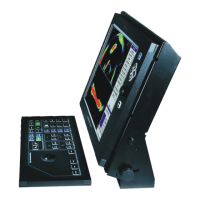Simrad SP70
8
850--164186 A
Reception
A great effort has been made to reduce unwanted noise to get a
clean and stable echo presentation. To achieve this goal the sonar
receiver has the following filtering possibilities:
FM CORRELATION FILTER
In addition to the traditional single frequency transmitting
method, the SP70 sonar is equipped with an FM correlation
mode.
In FM mode each transmission pulse contains up to 8 different
frequencies, and the receiver makes a spectrum analysis and
compares the received echoes with the transmitted frequency
code. This provides a filtering effect, which efficiently reduces
interference, noise and reverberation. In addition to giving a clean
and stable echo presentation, this will normally also increases the
sonar’s detection range
FREQUENCY SELECTION (OPTION)
The optional triple-frequency (24 kHz, 26 kHz and 28 kHz) and
multi-frequency (22 kHz, 23 kHz, 24 kHz, 25 kHz, 26 kHz, 27
kHz, 28 kHz, 29 kHz and 30 kHz) selections can be used for
suppression of interference from other sonars
AGC (Automatic Gain Control)
This control will automatically adjust the gain in the
preamplifiers, dependent on the strength of the incoming echo
signals. The strength of the filtering can be selected in the menu:
OFF, WEAK, MEDIUM and STRONG. Note that the AGC is
sensing the echo strength in five fixed directions, and use this as
a basis for adjusting all the receiver beams.
RCG (Reverberation Controlled Gain)
RCG is sensing the noise level (reverberation, propeller noise,
etc.), adjusting the gain individually for each of the 64 receiver
beams to eliminate the noise on the display. The strength of the
filtering can be selected in the menu: OFF, WEAK, MEDIUM and
STRONG. In the STRONG position, the RCG will effectively
reduce the bottom in shallow water, while variations on the
bottom will be displayed.
Note that scattered fish can be perceived as reverberation, so
therefore RCG should be used with care if scattered schools are to
be detected.
PP FILTER
The sonar is equipped with a ping- to- ping filter which gives a
clean and steady presentation by reducing the interference and
noise. This filter compares the echoes from a selected amount of
transmissions (pings), and an echo has to be present in the
selected amount of pings in order to be presented on the display.
The selection is made in the menu, with the following
possibilities:

